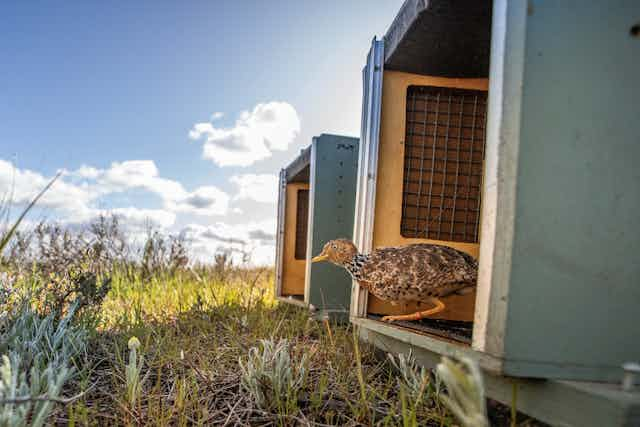Federal Environment Minister Tanya Plibersek has announced a much-anticipated overhaul of Australia’s national environment law. The plan is rich with welcome new policies – but the path to change is littered with hurdles.
The changes largely follow the recommendations of a major review of the law, known as the Environmental Protection and Biodiversity Conservation (EPBC) Act. The review by Professor Graeme Samuel was released in 2020. Speaking to ABC radio last week, Samuel expressed “complete elation and unqualified admiration and respect” for Plibersek’s comprehensive policy response.
The path of this big agenda stretches far beyond the one-term political horizon. I was a senior public servant responsible for managing and reforming the EPBC Act from 2007 to 2012. I’ve seen firsthand the obstacles to ambitious environmental reform.
Here are four hurdles Plibersek will have to jump, just for starters.

1. The absence of a climate trigger
The Greens and several crossbenchers have criticised Plibersek’s failure to include a so-called “climate trigger” in the reforms. This means the legislation’s passage through the Senate is not assured.
Legislating a climate trigger would mean a project’s future contribution to climate change would be assessed as part of the approvals process. This could mean a heavy-emitting project, such as an industrial plant or coal mine, is refused or its operations curtailed.
Plibersek has argued the federal government’s safeguard mechanism already regulates polluting facilities, and there’s no need to duplicate this.
Fair point. But critics also make a fair point: that Australia’s foremost environmental law does not deal with the most significant environmental threat of all.
There are opportunities for the federal government to introduce a limited climate trigger – for example, to large-scale land clearing. Such destruction is a significant contributor to Australia’s emissions, but is not covered by the safeguard mechanism.

2. Eliminating weasel words
The government’s new national environmental standards are the central plank of the reforms. Introducing such standards is a cutting-edge policy. The new federal Environmental Protection Agency will be tasked with ensuring the standards are adhered to.
Some standards will clearly describe the outcomes developments must meet – spelling out exactly what a healthy environment looks like. Projects will be required to align with this vision.
Other standards will describe processes needed to support the law’s proper functioning.
But drafting major changes to legislation is a fraught process – and the devil may yet creep into the detail.
The federal government must, in particular, weed out weasel words that might rob the standards of their punch – terms such as “as far as possible”.
And while the government’s reforms have been broadly welcomed by the business sector, it can expect opposition to its plan to extend standards to regional forestry agreements.
These agreements are currently exempt from the EPBC Act. In 2009, the Rudd Labor government dismissed a recommendation to review this exemption.
The Albanese government, very cautiously, says it will “begin a process” of applying the new national standards to regional forest agreements, in consultation with stakeholders.
No doubt Labor can still feel the rumbling of the 1995 blockade of Parliament House, when logging trucks blocked all entrances to the building for five days, after a dispute with the Keating government over woodchipping.

3. The difficulty of regional planning
Regional environmental plans will work in concert with the new national standards.
Regional plans will give guidance to decision makers, developers and communities on exactly what needs to be protected and where development should occur.
The federal government will partner with states and territories to identify locations where regional plans are needed. Plibersek has moved early, signing an agreement with Queensland to work together on the plans.
Even so, this is a long and winding road. Devising the plans is likely to be time-consuming, expensive and politically challenging. It will require new federal-state processes and good local consultation, and may highlight tensions about the future of particular regions.
4. Indigenous views and values
Plibersek has committed to giving First Nations people a greater say in environmental protection. As a start, the national standards applying to Indigenous engagement will be developed as a priority.
But respectful engagement is just the first step.
The Rudd government endorsed the UN Declaration on the Rights of Indigenous People. A parliamentary committee is now considering how it might apply in Australia.
Key to the declaration is the principle of free, prior and informed consent. Among other things, this means Traditional Owners should have the right to veto a development on their land – something the Native Title Act does not currently provide.
Read more: Water injustice runs deep in Australia. Fixing it means handing control to First Nations

Backing the future
Many other significant hurdles lie in the way of the government’s reforms.
Chief among them is the thorny issue of environmental offsetting, in which damage caused by a development in one area is compensated for by improving the environment “like for like” elsewhere.
Under the reforms, if a “like for like” replacement can’t be found, a proponent must make a “conservation payment” to fund biodiversity improvements elsewhere. As others have noted, this strategy is fraught with issues.
And it remains to be seen if the private sector will embrace the government’s plans to make it easier for the private sector to invest in environmental improvements, by creating “biodiversity certificates” to be bought and sold.
Unless the government offers incentives, it’s hard to see businesses rushing to take part. Special cases aside, there’s rarely profit to be made in restoring nature.
Finally, and most importantly, Plibersek must secure budget funding to implement these wholesale reforms. One recent study found federal and state spending on threatened species alone was 15% of what’s needed.
Above all else, the success of Plibersek’s plan requires strong backing from Prime Minister Anthony Albanese and his cabinet.

